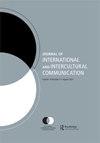美国同性恋战争肖像和同性恋武装档案文物
IF 2.2
Q2 COMMUNICATION
Journal of International and Intercultural Communication
Pub Date : 2021-09-06
DOI:10.1080/17513057.2021.1970209
引用次数: 0
摘要
本文采用了埃文·巴赫纳的《安逸:第二次世界大战的海军战士》摄影作品集。我认为,这些档案通过强化美国白人同性恋男性气概的历史形象,体现了无数同性恋民族主义的亲密关系。我把它的陈述放在全球色情军国主义、美帝国主义和亲密的黑人拒绝的背景下。本文章由计算机程序翻译,如有差异,请以英文原文为准。
U.S. homonationalist battle portraiture and queer armed archival artifacts
ABSTRACT This article engages the photographic collection archived in Evan Bachner’s At Ease: Navy Men of World War II. I argue that this archive embodies myriad homonationalist intimacies through the reinforcement of historical images of White U.S. American queer-coded masculinity. I place its representations against a backdrop of global pornographic militarism, U.S. imperialism, and intimate Black refusal.
求助全文
通过发布文献求助,成功后即可免费获取论文全文。
去求助
来源期刊

Journal of International and Intercultural Communication
COMMUNICATION-
CiteScore
3.80
自引率
12.50%
发文量
19
 求助内容:
求助内容: 应助结果提醒方式:
应助结果提醒方式:


